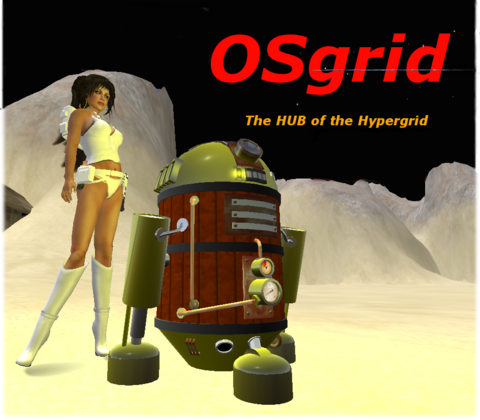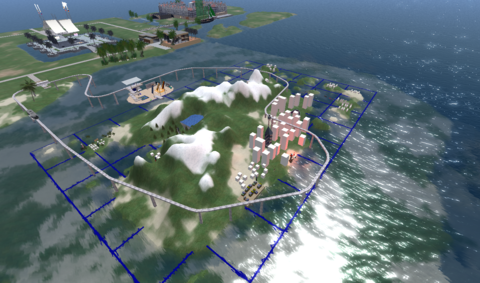Overview
OSgrid is a virtual world's platform or virtual grid running the Open Simulator software based on Second Life protocols. The server software was developed by a bunch of open source developers when, in 2007, Linden Labs released their SL viewer code into the public domain. Some call OpenSim, as it became known, a Second Life clone although there are many difference where some are marked improvements like Hypergrid and mega regions (explained further on) while other features like first class physics have been noticeably lacking. OSgrid is the oldest of the grids running OpenSim and it was set up by the developers to test the server code. They do, however, allow anyone who is running the free software to connect their regions to OSgrid and it's asset servers. Thus, OSgrid has developed a sizable community with around 10,000 private regions and over 120,000 registered users.

What makes OpenSim and therefore OSgrid markedly different from Second Life is Hypergrid which allows users to grid hop or teleport out from OSgrid to any number of the other private and commercial grids running the OpenSim software. Users can, in effect, travel around the Metaverse from grid to grid with their full appearance and access to inventory from their home grid which brings to mind the fictional Metaverse as depicted in Snowcrash and William Gibson's Neuromancer. But, of course, the modern Metaverse is not all about Cyberpunk for it has spawned many creative uses not least gaming and role playing.
What made Second Life great has been carried over into the open Metaverse and user's created content made with in-world building tools similar in some ways to Garry's Mod. If a grid chooses to implement a token currency, which the software supports, then items can be bought and sold in-world and, just the same as in Second Life, a virtual economy can exist in which people are making real world cash from content sales and hosting grids and regions for users. OSgrid, however, remains a none-profit grid but hosting companies are permitted to host regions for private users. Other commercial grids are generally found to be running a full economy with their own token currency or Paypal micro payments. There is also OMC universal currency on many grids too.
The physics engine of OpenSim has been the main let down to otherwise excellent software. Second Life runs on the Havoc physics so is far better. However, work is going on to improve OpenSim's physics engine. Bullet physics is being steadily improved while a forked version of OpenSim under development by the InWorldz grid is working towards implementing PhysiX from Nvidia. Another improvement over Second Life that I touched on above are VAR (variable size ) regions which is basically a way of connecting many regions together to form a bigger seamless space with no border crossings.
Currently, as of September 2017, there are over 300 grids running on OpenSim which is free to download and run as a white label grid or standalone instance connected to an established grid like OSgrid.
Getting Started
To join OSgrid one just has to go to the web site at https://www.osgrid.org and register an avatar name then download a client viewer to enter the world. Most viewers have a grid manager with a list of grids to visit including OSgrid. Enter the avatar name and password then login. Useful viewers include Kokua, Singularity and Firestorm, aswell as various others.
When logged into OSgrid the avatar will land at a LBSA plaza and, while initially the avatar will appear very basic, this can be improved easily with free content including skins, shape and clothes in the Welcome region. When ready the avatar set off to explore and find new freebies around the grid. Generally, there is always people around at the Welcome region so don't be too shy to ask for help. The mentors are only too willing.

One of the first things to get to know is how to use the avatar's Inventory. All content is stored there and it is really quite easy to deal with. Generally, just right click an item in the Inventory list and click wear to have the avatar wear it. There are attachment points all over the avatar so anything can be moved about and the last place it was fixed will be what the wear instruction remembers. So, getting something new just means clicking on item such as a sale's board or box and using the pie menu to select an option which may include Free to Copy, Take or Buy. Selecting an action will bring the item to inventory and it will initially be found under the Recent folder or in Objects folder. If the item, or items such as clothing, is boxed then drag it to the floor in a region that allows objects to be "rezzed" and right click and Open. Opening it will give a choice to Wear all the content or save to inventory where can be found and attached individually.
Once familiar with Inventory one can then explore the viewer tabs and options to chat, voice and use gestures before setting off into the grid by using Landmarks or search to find places of interest to visit.
Content Creation
Building and making content in OpenSim grids is almost identical to the way it is done in Second Life. Just right click on the ground in a region where building is allowed and click create in the menu that appears. A very basic block or primitive object will appear. The primitives or prim's can have a number of shapes including a cube and a sphere and these can be stretched, shrunk or enlarged in every direction. Right clicking the block at any time will bring up a menu with Edit options to change the block after. The creator can set permissions such as Modify, Copy and Transfer.
Prim's can also be linked together to form a more complex object such as a house, a flower vase or even clothing that can be worn by avatars. Objects can be textured too by buying or downloading textures to the Inventory folder then selecting any of the faces or sides of each object and adding a texture to it. In this way a very detailed object can be built up for use in the world or on avatars. Some complex objects like vehicles can even be made to move and driven around the region. This requires scripting and scripts can be added to each and every object to make it move or do a host of other things such as weapons that can be fired or doors that can be opened and closed.

OpenSim also makes use of sculpted prim's to generate even more irregular shapes that can look much like a Mesh object which is what they basically are. And, of course, OpenSim can handle full mesh objects that can make the world and avatars look even more realistic.
Scripting
OpenSim has a very similar scripting language to Second Life. LSL and many scripts developed in SL will work with little to no change in an OpenSim grid. However, not all will and changes might be necessary. LSL is a derivative of C and very similar to Java script but runs as a state engine which means the script is active while in various states. There could be a state where a light is on and a state where a light is off for example. Opensim also has it's own script functions using the prefix OSSL and more specialized functions for bots or osNPC functions. In addition C# scripts can be used too which makes OpenSim a rich programming environment.
Hosting OpenSim
OSgrid does not provide free full regions of virtual land (you can get a free plot to put up a home, if available on one of the public OSgrid plaza's) but there are established commercial hosts like Dreamland Metaverse and Simhost that do. Shopping around can also find hosting companies that can set up a region and host it for as little as $10 a month or one can pay for a virtual dedicated server on which to run the OpenSim software and have even more regions at lower cost. Enterprising folks can even become a host or Land Baron themselves and go into business renting out land to others. Many people new to OpenSim have used OSgrid to become familiar with the software and have run their own regions on their own server in their homes. After a while some will then open their own grid independently of OSgrid and they may enable Hypergrid and keep a single portal region in OSgrid in order to maintain a connection with their own grid as well as other grids in the open Metaverse.

OSgrid has gained the reputation of being the HUB of the Hypergrid with many smaller grids connecting via portal regions but other grids chose not to enable Hypergrid for greater security which basically means not allowing content to leave their grid and risk being copied. This has given rise to a culture of closed commercial grids, or walled gardens like Second Life and it's opposite, a more utopian share and share alike attitude in a great many of the Hypergrid enabled grids. But even then content is being sold under a creative commons license on many grids anyway which allows more content to be moved about and this is giving rise to a much larger market than any single commercial grid can build for itself.
OSgrid is the biggest grid running OpenSim but there are over 300 grids currently (as of September 2017) ranging from closed commercial grids to fully fledged role play and gaming worlds and that's quite apart from the many Hypergrid enabled grids. In addition many new grids are opening for Universities and collages as well as proof of concept modelers and business conferencing. Government also has grids and even the US Army runs the Moses grid for simulation and training.
Log in to comment